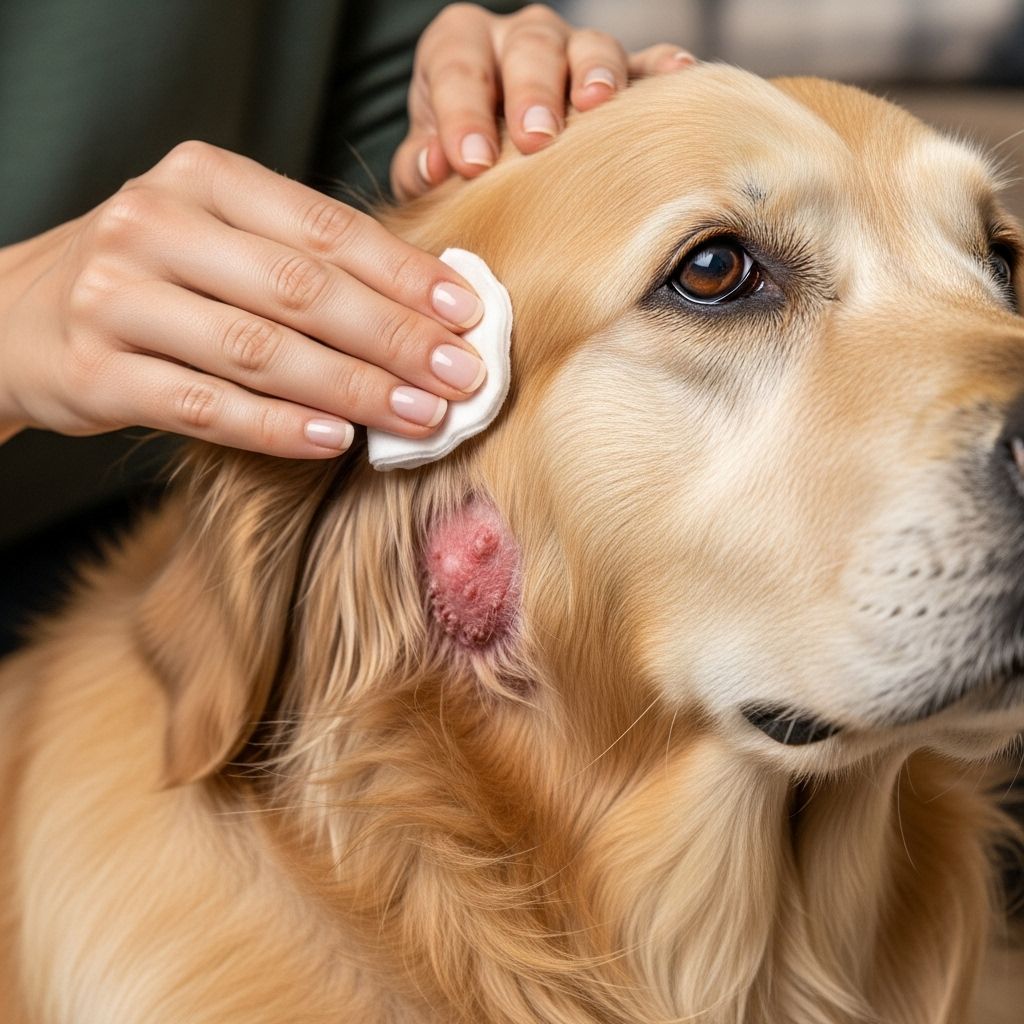Treating Dog Hot Spots with Effective Home Remedies
Discover practical, safe, and natural home remedies to treat and prevent hot spots in dogs while promoting overall skin health.

Dog Hot Spots: Understanding, Treatment, and Prevention with Home Remedies
Dog hot spots, known medically as acute moist dermatitis, are a common skin condition in which localized areas of a dog’s skin become inflamed, painful, and infected. These spots can rapidly worsen, making prompt and proper care critical for your pet’s comfort and health. If you notice your dog is incessantly scratching, licking, or biting a specific area, it’s essential to take proactive steps to manage hot spots using safe home remedies alongside proper hygiene and veterinary guidance.
What Are Hot Spots on Dogs?
Hot spots are red, swollen patches on the skin that often ooze pus and can be extremely uncomfortable for dogs. They can develop quickly and commonly occur around the head, neck, hips, and limbs. The primary causes include:
- Excessive scratching, licking, or biting due to allergies or irritation
- Moisture trapped under the fur
- Bacterial infections
- Poor grooming or unaddressed wounds
- Underlying skin conditions
Left untreated, hot spots can spread and lead to deeper infections. Understanding their root causes is essential for effective treatment and prevention.
Recognizing Hot Spots: Symptoms to Watch
- Redness and swelling on the skin
- Oozing or crusting lesions
- Hair loss around the affected area
- Persistent licking, biting, or scratching
- Warmth at the site
- Noticeable discomfort or restlessness
Early detection helps prevent worsening symptoms and facilitates easier treatment and healing.
Home Remedies for Treating Dog Hot Spots
Many hot spots can be treated at home, especially when caught early. Below are safe, effective remedies supported by expert guidance:
1. Restrict Licking and Scratching
Prevent your dog from biting or licking the affected area. Consider an Elizabethan collar (cone) or a soft recovery collar to allow the wound to breathe and heal without further irritation.
2. Trim the Fur Around the Hot Spot
Carefully clip or trim fur around the hot spot to prevent hair from trapping heat and moisture, enabling better air exposure and cleaner application of remedies. Use blunt-end scissors and disinfect tools thoroughly prior to use.
3. Gentle Cleaning
- Clean the area with a mild antiseptic solution such as chlorhexidine (available in liquid or medicated wipes formulated for dogs). Avoid using human skin ointments containing zinc oxide, which is toxic to dogs.
- You can also use a solution of warm water and Himalayan salt (one teaspoon salt per cup) to gently wash the area, providing an antibacterial effect while soothing irritation.
4. Cool Compresses
Applying a cool, wet compress (such as a damp washcloth) to the hot spot for 2-4 minutes, several times daily, helps reduce inflammation and pain. Always dry the skin gently after, as excess moisture can aggravate the condition. Avoid ice packs, which may cause discomfort.
5. Topical Home Remedies and Natural Solutions
- Calendula: Apply calendula lotion or cream to promote healing, reduce itching, and soothe irritation. Calendula can be prepared by diluting 20 drops of tincture in one cup of water with ¼ teaspoon salt, used as a gentle sponge wash on the hot spot.
- Hypericum (St. John’s Wort): When combined with calendula, it enhances pain relief and promotes healing. Mix tinctures of both in warm water and gently dab onto the sore area.
- Black Tea: The tannins in black tea are drying and ward off bacterial infections. Steep a black tea bag, cool, and apply to the hot spot several times daily for optimal results.
- Coconut Oil: With natural antibacterial and soothing properties, coconut oil can be lightly applied to the area to help reduce irritation and support healing.
- Aloe Vera: Use dog-safe aloe vera gel to alleviate swelling and discomfort. Avoid formulations that contain alcohol or artificial colors.
- Apple Cider Vinegar: Mix equal parts apple cider vinegar and warm water, shake, and apply to the hot spot using a cotton ball or spray. This can soothe itchiness but should not be used on open wounds, as it may sting.
- Colostrum: Colostrum powder mixed with water can be applied topically to help repair skin and prevent infection. Remove the paste daily and reapply as necessary.
6. Over-the-Counter Medications
- Oral antihistamines such as diphenhydramine (Benadryl) or cetirizine (Zyrtec) may help with itching. Always consult your veterinarian for the correct dosage and suitability for your dog.
7. Dietary Supplements for Skin Health
- Essential fatty acids (Omega-3s from fish oil) help maintain skin integrity and reduce inflammation.
- Vitamins A, C, and E are vital for skin repair and resilience. Consider adding canine-safe supplements if recommended by your vet.
- Probiotics may help restore balance to your dog’s system, minimizing future skin flare-ups.
When to Seek Veterinary Care
While most mild cases can be managed at home, contact your veterinarian promptly if:
- The hot spot worsens, spreads, or shows no improvement within 3 days
- The wound is excessively painful, deep, or oozing pus
- Your dog shows signs of lethargy, fever, or decreased appetite
- You are unsure about the diagnosis or best course of treatment
Some severe or persistent hot spots may require prescribed antibiotics or other medical interventions.
Preventing Hot Spots in Dogs
Prevention focuses on overall skin health and minimizing triggers for skin irritation:
- Regular grooming: Brush your dog’s coat frequently to remove dead fur and prevent matting.
- Dry after bathing or swimming: Ensure all moisture is dried from fur and skin.
- Manage allergies: Work with your vet to identify and control environmental or food allergies.
- Flea and parasite control: Administer appropriate preventative medications and inspect regularly.
- Promptly treat wounds: Clean and address injuries before they become infected.
- Balanced diet: Provide skin-supporting nutrients and supplements.
Common Causes and Risk Factors for Dog Hot Spots
| Cause | Description |
|---|---|
| Allergies | Environmental, food, or contact allergies can trigger persistent itching and skin inflammation. |
| Parasites | Fleas, ticks, and mites often prompt excessive scratching and biting leading to skin wounds. |
| Moisture | Wet fur or skin trapped under collars or harnesses fosters bacterial growth. |
| Anxiety/Stress | Nervous dogs may develop compulsive licking and biting behaviors. |
| Poor Grooming | Dirty or matted fur creates hot, damp environments where infections thrive. |
| Underlying Health Issues | Conditions like hypothyroidism, autoimmune disease, or hormone imbalances can increase susceptibility. |
Frequently Asked Questions (FAQs)
Q: What is the fastest way to cure a hot spot at home?
Gently clip the surrounding fur, clean with a non-irritating antiseptic like chlorhexidine, restrict licking/biting, and use a natural remedy such as calendula or aloe vera. Seek veterinary advice if the spot worsens.
Q: Can I use human topical ointments on my dog’s hot spot?
No. Many human creams, particularly those containing zinc oxide or alcohol, are toxic to pets. Instead, use home remedies specifically formulated for canine use.
Q: How can I stop my dog from licking the hot spot?
Use an Elizabethan collar or cone, increase supervision, and keep your dog occupied with safe toys or activities.
Q: Are hot spots contagious to humans or other pets?
Hot spots themselves are not contagious, but secondary infections caused by bacteria can be transferred, especially in multi-pet households with open wounds. Practice good hygiene during care.
Q: When should I take my dog to the vet rather than treat at home?
If the hot spot does not improve in 48–72 hours, spreads quickly, becomes very painful, or your dog acts unwell, seek professional veterinary care.
Additional Tips for Managing and Healing Hot Spots
- Monitor your dog’s overall behavior and appetite during treatment.
- Use only clean towels and tools to prevent introducing more bacteria.
- Address underlying itch causes such as fleas or allergies to prevent recurrence.
- Never bandage or cover hot spots tightly as they need air to heal.
- Document progress with photos to share with your vet if needed.
Safe Home Ingredients and Their Uses in Hot Spot Care
| Ingredient | Benefit | How to Use |
|---|---|---|
| Coconut Oil | Antibacterial, moisturizing | Apply a thin layer on clean, trimmed hot spot twice daily. |
| Calendula | Calming, healing, anti-inflammatory | Dilute tincture in water & salt, sponge onto hot spot 2–4 times daily. |
| Aloe Vera | Reduces swelling and heat, soothes pain | Apply gel, ensuring product is dog-safe, as needed. |
| Apple Cider Vinegar | Antibacterial, anti-itch | Mix 1:1 with water and spray onto the area, avoid open sores. |
| Black Tea | Dries & soothes, prevents bacterial infection | Apply cooled tea bag or cotton ball soaked in tea several times daily. |
What Not to Do When Treating Dog Hot Spots
- Do not use strong alcohol, hydrogen peroxide, or harsh soaps that can delay healing or cause pain.
- Do not delay treatment—hot spots spread rapidly.
- Avoid wrapping or bandaging the hot spot; air exposure is crucial.
- Do not ignore persistent licking, as it usually signals discomfort or infection.
Conclusion
While hot spots can be distressing for dogs and their owners, prompt and careful home treatment using proven remedies can offer relief and support skin healing. Use gentle cleaning, natural topical solutions, and proper supervision to restrict self-trauma. Prevention, balanced nutrition, and regular veterinary input are key to minimizing recurrences and supporting your pet’s overall skin health.
References
- https://www.petmd.com/dog/general-health/hot-spots-dogs
- https://fureverfriendsnc.org/treating-hot-spot-on-your-dog/
- https://www.goodrx.com/pet-health/dog/hot-spot-treatment-for-dogs-at-home
- https://www.holistapet.com/blogs/home-remedies-for-dogs/hot-spots
- https://www.petmd.com/dog/general-health/home-remedies-for-dog-itchy-skin
- https://www.vet.cornell.edu/departments-centers-and-institutes/riney-canine-health-center/canine-health-information/hot-spots
- https://www.dogsnaturallymagazine.com/ultimate-guide-hot-spots-on-dogs/
- https://wagwalking.com/wellness/natural-solutions-to-your-dogs-problem-hot-spots
Read full bio of medha deb












